
Search
The Renewable Energy site for Do-It-Yourselfers
A Unique Open Flow
Solar Pool Heating Collector
| Matt has done a really nice job on this easy to build, efficient,
and inexpensive pool heating collector.
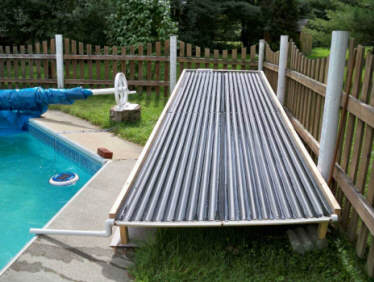
This is a unique, open flow collector design which reduces cost while
still providing high efficiency. The collector pump is powered by its own PV panel and heats the pool
without using any external power source. The collector price comes
in at about one third of what commercial pool collectors cost. |
|
Collector
The collector uses corrugated metal roofing as the absorber. Heat is
picked up from the solar heated roofing by small trickles of water that flow
down the valleys in the roofing. This makes for a really simple and
inexpensive collector design that operates efficiently and should have a long
life.
Water is pumped from the pool to a header along the top of the collector.
The header squirts a small stream of water into each valley in the corrugated
roofing material. At the bottom of the collector, the heated water flows
into a channel which carries the water back to the pool.
While there is some heat loss from evaporation of the exposed water, the fact
that the water is confined to a relatively small area keeps these loses low, and
the collector efficiency is comparable to commercial unglazed pool heating
collectors.
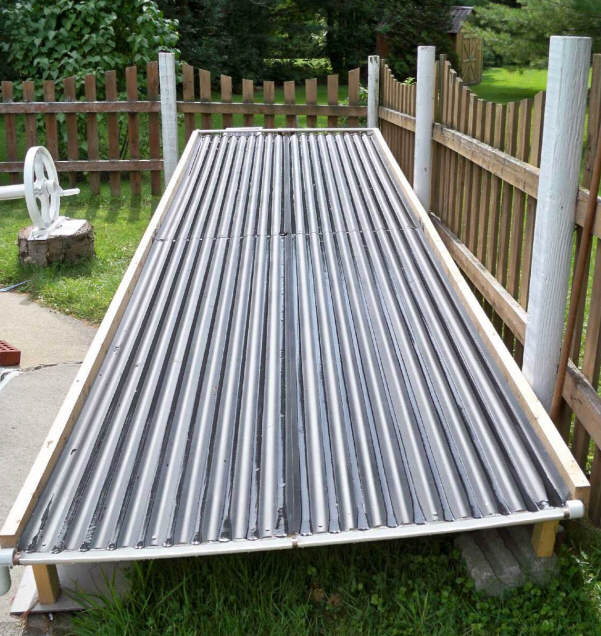
The pump that circulates water over the collector is PV powered, so this pool
heater does not require running the pool pump and does not require any external
power source.
Using the PV panel provides automatic control in that when the sun is out
enough to power the pump the collector will be absorbing enough heat to heat the
pool water.
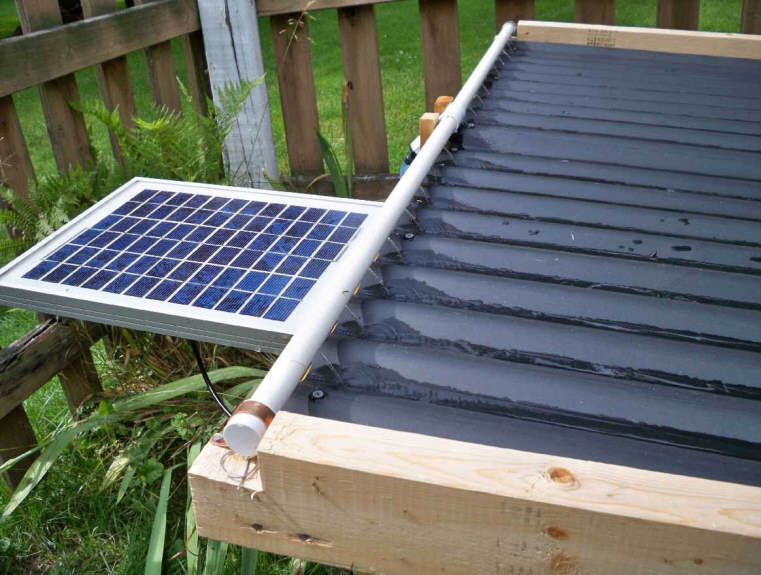
This picture shows the header distributing pool water to the corrugated roofing
valleys. The PV panel
that powers the pump is visible to the left.
The pictures below show the plumbing arrangement. The PV powered
submersible pump lifts water from the pool to the top of the collector where it
is dribbled into the corrugated roofing channels. The water flows down the
channels extracting heat from the corrugated metal absorber. The heat is
returned to the pool by the short drain pipe at the bottom end of the panel.
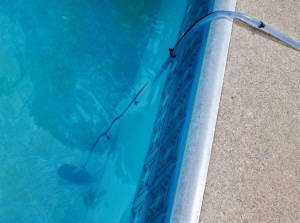
The collector is supplied with water via
this inlet line and a submersible pump at the
bottom of the pool. |
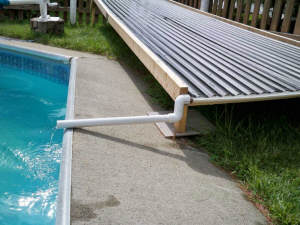
This picture shows the channel and pipe
that return heated water to the pool. |
Cost
Based upon
the design of a Thomason trickle collector patented in the 1950s, this one uses
a solar powered pump to circulate the water from the pool, across the collectors
and back into the pool.
Materials
list:
|
Qty |
Item |
Unit
Cost |
Total
Cost |
|
4 |
26" X
96" galvanized 29 ga. corrugated metal roofing panels |
$14.99 |
$59.96 |
|
5 |
2X4
boards, 8' long |
$2.80 |
$14.00 |
|
4 |
2X3
boards, 8' long |
$2.80 |
$11.20 |
|
2 |
Galvanized end-to-end board connectors |
$4.95 |
$9.90 |
|
1 |
Quart
Flat Black Rustoleum oil-based paint |
$9.00 |
$9.00 |
|
1 |
Quart
Rustoleum primer for aluminum and galvanized steel |
$9.00 |
$9.00 |
|
1 |
Pint
mineral spirits |
$4.95 |
$4.95 |
|
1 |
8W
Photovoltaic Panel and submersible pump with 16' power cord |
$98.00 |
$98.00 |
|
1 |
Box
3" galvanized outdoor screws |
$4.95 |
$4.95 |
|
15' |
1/2"
clear vinyl tubing |
$0.69
/ ft |
$10.35 |
|
2 |
1/2"
Copper pipe brackets |
$0.69 |
$1.38 |
|
5' |
1/2"
PVC pipe |
$0.69 |
$3.45 |
|
1 |
1/2"
PVC tee |
$0.79 |
$0.79 |
|
2 |
1/2"
PVC end caps |
$0.59 |
$1.18 |
|
7' |
2"
PVC pipe |
$1.10 |
$7.70 |
|
1 |
2"
PVC end cap |
$0.89 |
$0.89 |
|
2 |
2"
PVC elbows |
$1.49 |
$2.98 |
|
3 |
2"
PVC pipe brackets |
$0.89 |
$2.67 |
|
1 |
Bottle PVC cement |
$4.95 |
$4.95 |
|
Total: |
$257.30 |
Total cost
$260.00
Collector
area: 4.33 ft X 16 ft = 69.33 sq. ft.
Cost per
square foot = 260/69.33 = $3.75 (full system including pump, PV,
...)
Collector only cost
per square foot = $125/69.33 = $1.80
Time: Not
really sure, but I would guess 6-8 hours labor, painting, construction,
tweaking.
Performance
Pool
Information:
26' diameter
octagonal pool, 4' deep, holding about 18,500 gallons (153,000 lbs. water)
Heater
Performance:
Pump moves
about 50 gallons of water over the collectors when in full sun (415 lbs. water
per hour)
My latest
temperature measurements were water going into pump was 72 degrees F, and water
coming back into the pool was 99 degrees F, an increase of 27 degrees.
(99F -
72F)X (415 lbs/hour)X(1 BTU/lb-F) = 11,200 BTUs per hour
This going
into the whole pool (153,000) lbs water would raise the temp about .07 degrees,
or over the course of 5-6 hours would raise the temp about 0.36 of a degree, or
maybe on a good, hot sunny day I might get 7-8 hours of running time with lower
performance at the beginning and end of the day and maybe even better when the
sun is high, resulting in an average 0.5 degree pool temp increase per day.
In the actual
pool I saw even better than this, probably due to gains from the solar pool
cover and at one point the pool reached 80 degrees and I had to shut down the
heater! I now find it is best to let it run because here in Vermont you need to
take full advantage of the sunny days since you never know when there will be
clouds for a week straight, as the pool cooled back down to 70 F when I did
this.
Matt
Williston, VT
Matt will answer email questions:
mattvt AT hotmail DOT com (change AT to an @ and DOT to a period)
Comments on Matt's Pool Heater:
Its really nice to see this collector design up and working on an actual
pool. Matt's design is to some degree based on
this test collector I did a while back, and I was really hoping that someone
would give it a try on a real pool and report back on how it worked out.
Matt not only did this, but did a really nice job of integrating it with the
pool. I really like the simple plumbing and the solar powered pump -- this
project made my whole week :)
For those who might have some doubts about the efficiency of a collector that
has open flow of water that can lose heat by evaporation, have a look at the
performance test on this page. For reasons explained along with the
test results, the collector actually has good efficiency.
As Matt says, the fact that this relatively modest sized collector does an
acceptable job of heating the pool probably says a lot for having a good pool
cover and using it.
The same collector arrangement can also be used in a
radiative/evaporative cooler arrangement.
Gary
Gary August 5, 2010





